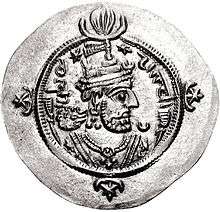Kavadh II
| Kavadh II | |
|---|---|
| Great King (Shah) of Ērānshahr | |
 Coin of Kavadh II. | |
| Reign |
25 February 628 – 6 September 628 |
| Predecessor | Khosrau II |
| Successor | Ardashir III |
| Born | 590 |
| Died |
6 September 628 Dastagird |
| Spouse | Anzoy the Roman |
| Issue | Ardashir III |
| House | House of Sasan |
| Father | Khosrau II |
| Mother | Maria |
| Religion | Dyophysite Christian |
Shērōē (also spelled Shīrūya, شیرویه), better known by his dynastic name of Kavadh II (New Persian: قباد Qobād or Qabād), was king of the Sasanian Empire briefly in 628. He was the son of Khosrau II (590–628). He became king after orchestrating a coup d'état against his father.
Biography
Kavadh II was the son of Khosrau II, the king of the Sasanian Empire, and Maria, daughter of Maurice, the emperor of the Byzantine Empire. Kavadh was later imprisoned by his father who wanted to ensure the succession of his favorite son Mardanshah, the son of his favorite wife, Shirin. His father's reputation had been ruined during the last phase of the Byzantine–Sasanian War of 602–628.
In 627, the Sasanian general Rhahzadh was slain and Dastgerd, the king's favorite residence, had been sacked by Heraclius, who was advancing towards Ctesiphon. In 628, Kavadh was released by the feudal families of the Sasanian Empire, which included: The Ispahbudhan spahbed (army chief) Farrukh Hormizd and his two sons Rostam Farrokhzad and Farrukhzad, Shahrbaraz of the House of Mihran, the Armenian faction represented by Varaztirots II Bagratuni and finally the Kanarang.[1]
On 25 February, Kavadh, along with Aspad Gushnasp, captured Ctesiphon and imprisoned Khosrau II. Kavadh II then proclaimed himself as king of the Sasanian Empire and ordered the execution of all his brothers and half-brothers, which included Mardanshah, the favorite son of Khosrau II. Three days later he ordered Mihr Hormozd to execute his father. However, after the execution of his father, Kavadh had Mihr Hormozd killed.[2]
With the agreement of the Persian nobles, Kavadh then made peace with the Byzantine emperor Heraclius, which enabled the Byzantines to regain all their lost territories, their captured soldiers, a war indemnity, along with the True Cross and other relics that were lost in Jerusalem in 614.[3][4]
Kavadh also appointed Varaztirots II Bagratuni as Marzban of Persian Armenia, and appointed Ishoyahb II as the new patriarch of the Church of the East.[5] Kavadh II later died from plague after a few months' reign on 6 September 628. He was succeeded by his eight-year-old son Ardashir III for whom he decreed Emperor Heraclius act as regent. These decisions along with his Christian faith led the Zoroastrian priesthood to eliminate him and his young heir not long after.
Marriage
A passage of the Chronicle of Edessa identifies "Anzoy the Roman" as the wife of Kavadh II and mother of Ardashir III. The woman was probably a Christian princess from the Byzantine Empire.[6]
In popular culture
Siroe is the subject of operas by a number of composers including Pasquale Errichelli, Johann Adolph Hasse, Leonardo Vinci, Antonio Vivaldi and George Frideric Handel.
References
Sources
- Martindale, John R.; Jones, A.H.M.; Morris, John (1992), The Prosopography of the Later Roman Empire, Volume III: AD 527–641, Cambridge University Press, ISBN 0-521-20160-8
- Morony, Michael G. (2005) [1984]. Iraq After The Muslim Conquest. Gorgias Press LLC. ISBN 978-1-59333-315-7.
- Pourshariati, Parvaneh (2008). Decline and Fall of the Sasanian Empire: The Sasanian-Parthian Confederacy and the Arab Conquest of Iran. London and New York: I.B. Tauris. ISBN 978-1-84511-645-3.
- Shapur Shahbazi, A. (2005). "SASANIAN DYNASTY". Encyclopaedia Iranica, Online Edition. Retrieved 30 March 2014.
- Al-Tabari, Abu Ja'far Muhammad ibn Jarir (1999). Yar-Shater, Ehsan, ed. The History of Al-Tabari: The Sasanids, the Lakhmids, and Yemen. Trans. David Waines. Albany, NY: State University of New York Press. ISBN 0-7914-0764-0.
| Wikimedia Commons has media related to Kavad II. |
| Kavadh II | ||
| Preceded by Khosrau II |
Great King (Shah) of Ērānshahr 25 February 628 – 6 September 628 |
Succeeded by Ardashir III |